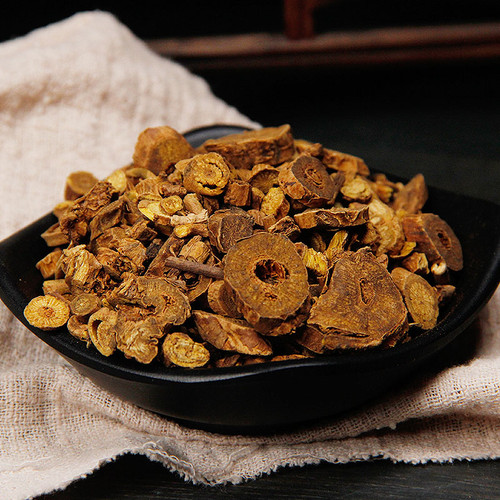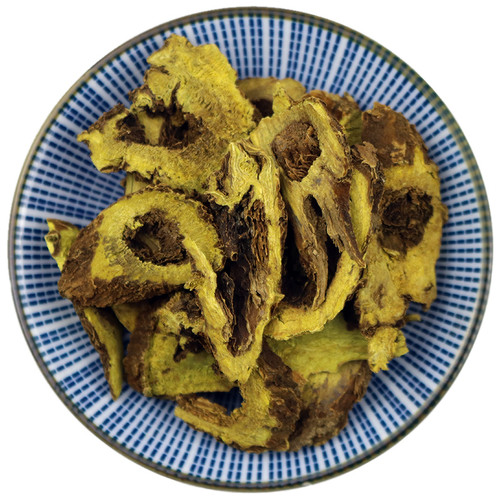Product Overview
Parts used: Dried root
TCM category: Herbs that clear Heat and dry Dampness
TCM nature: Cold
TCM taste(s): Bitter
Meridian affinity: Gallbladder Spleen Heart Large intestine Lung Small intestine
Scientific name: Scutellaria baicalensis
Other names: Scute, Chinese skullcap
Use of baikal skullcap roots (Huang Qin) in TCM
Please note that you should never self-prescribe TCM ingredients. A TCM ingredient is almost never eaten on its own but as part of a formula containing several ingredients that act together. Please consult a professional TCM practitionner, they will be best able to guide you.
Preparation: Remove impurities, steam for half an hour, cut in thin slices, dry.
Dosage: 3 - 9 grams
Main actions according to TCM*: Expels Heat and Dampness. Clears Upper Burner Heat, especially of the Lung. Clears Heat and stops reckless movement of Blood. Clears pathogenic Heat which is upsetting the fetus. Cools the Liver, reducing Liver Yang rising syndrome.
Primary conditions or symptoms for which baikal skullcap roots may be prescribed by TCM doctors*: Chest pain Vomiting Dysentery Jaundice Coughing Bloody sputum Nosebleed Carbuncles Sores Miscarriage
Contraindications*: This herb should not be used by those with Deficiency Heat in the Lungs, with Coldness in the Middle Burner with diarrhea, nor by those mothers with restless fetus due to Cold conditions.
Common TCM formulas in which baikal skullcap roots are used*:
For severe high fever combine baikal skullcap roots with honeysuckle flowers (Jin Yin Hua) and goldthread rhizomes (Huang Lian).
For asthma or chronic bronchitis combine baikal skullcap roots with ginkgo nuts (Bai Guo), ephedra (Ma Huang), perilla seeds (Zi Su Zi), coltsfoot flowers (Kuan Dong Hua), apricot seeds (Xing Ren), mulberry bark (Sang Bai Pi), crow-dipper rhizomes (Ban Xia) and liquorice (Gan Cao).
For Deficient Kidney and Liver Yin patterns with symptoms such as dizziness, vertigo, blurred vision, headache and hypertension combine baikal skullcap roots with heal-all spikes (Xia Ku Cao), gambir stems and thorns (Gou Teng) and chrysanthemum flowers (Ju Hua).
For high fevers with delirium and unconsciousness combine baikal skullcap roots with cape jasmine fruits (Zhi Zi), forsythia fruits (Lian Qiao) and fermented soybeans (Dan Dou Chi).
For cough with thick yellow phlegm combine baikal skullcap roots with anemarrhena rhizomes (Zhi Mu) and snake gourds (Gua Lou).
For harmonizing Internal and External symptoms, Cold and Heat, Excess and Deficiency and treating associated symptoms (common cold, influenza, pneumonia, indigestion, nervous exhaustion, etc.) combine baikal skullcap roots with jujube dates (Da Zao), bupleurum roots (Chai Hu), crow-dipper rhizomes (Ban Xia), white peony roots (Bai Shao), ginseng (Ren Shen), cinnamon twigs (Gui Zhi), fresh ginger (Sheng Jiang) and liquorice (Gan Cao).
For Heat in the Liver and its channel with symptoms of fever, headache, red eyes, dizziness and abdominal distention combine baikal skullcap roots with aloe vera (Lu Hui).
For headaches caused by hyperactive Liver Yang with hypertension combine baikal skullcap roots with gastrodia rhizomes (Tian Ma), gambir stems and thorns (Gou Teng) and achyranthes roots (Niu Xi).
For Damp Summer-Heat with nausea, malaria and high fever combine baikal skullcap roots with sweet wormwood herbs (Qing Hao) and crow-dipper rhizomes (Ban Xia).
For dysentery due to Damp-Heat combine baikal skullcap roots with purslane (Ma Chi Xian) and goldthread rhizomes (Huang Lian).
Key TCM concepts behind baikal skullcap roots (Huang Qin)'s properties
In Traditional Chinese Medicine (TCM), baikal skullcap roots are plants that belong to the 'Herbs that clear Heat and dry Dampness' category. Herbs in this category are used to clear inflammatory and infectious conditions, referred to as 'Internal Heat' in TCM. This is why most of the herbs in this category will have both antibacterial and antiviral properties. In TCM one has too much 'Heat' in their body as a result of a deficiency of 'Yin' (which is Cold in nature, see our explanation on Yin and Yang) or, more commonly, an excess of Yang (Hot in nature). Herbs that clear Heat and dry Dampness treat the latter while, at the same time, relieving the body of excess Dampness. As such they tend to be Cold or Neutral in nature.
As suggested by its category baikal skullcap roots are plants that are Cold in nature. This means that baikal skullcap roots typically help people who have too much "heat" in their body. Balance between Yin and Yang is a key health concept in TCM. Those who have too much heat in their body are said to either have a Yang excess (because Yang is Hot in nature) or a Yin deficiency (Yin is Cold in Nature). Depending on your condition baikal skullcap roots can help restore a harmonious balance between Yin and Yang.
Baikal skullcap roots also taste Bitter. The so-called "five elements" theory in Chinese Medicine states that the taste of TCM ingredients is a key determinant of their action in the body. Bitter ingredients like baikal skullcap roots tend to have a cleansing action on the body by clearing heat, drying dampness and promoting elimination via urination or bowel movements.
The tastes of ingredients in TCM also determine what organs and meridians they target. As such baikal skullcap roots are thought to target the Gallbladder, the Spleen, the Heart, the Large intestine, the Lung and the Small intestine. Similar to modern medicine, in TCM the Gall Bladder stores and releases bile produced by the Liver. It also controls the emotion of decisiveness. The Spleen on the other hand assists with digestion, blood coagulation and fluid metabolism in the body. In addition to regulating blood flow, the Heart is believed to be the store of the "spirit" which basically refers to someone's vitality. The Large Intestine receives the "impure" parts of the digested food from the Small Intestine, absorbs the remaining fluids and excrete the remainder as feces. In addition to performing respiration, the Lungs are thought to be a key part of the production chain for Qi and the body fluids that nourish the body. Like the Stomach, the Small Intestine has a digestive role, extracting the "pure" part of what we injest to the Spleen and the "impure" down to the Large Intestine.










